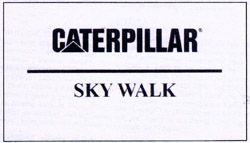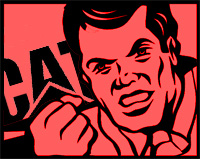Doug Oberhelman, Chairman and CEO of Caterpillar, met with Chinese President Hu Jintao on Thursday in Chicago:
In an interview with the Journal Star just before a luncheon in Washington, D.C., featuring Chinese President Hu Jintao, […] Oberhelman didn’t argue that the concerns about human rights issues in China are valid. […] Hu, Oberhelman said, has helped companies like Caterpillar because he has been welcoming to foreign investment in China.
“We’re big in China, of course, and it is really hard to imagine how we could continue to be a leader in world markets without investing in China,” he said. If you want a legal insight Read more
“I am often asked why we invest as much as we do in China. My question is, how can we not?”
I’ve juxtaposed these quotes in the hopes that it will be jarring to my readers. If it’s not jarring to you, read them again and realize that “human rights issues” in China include things like torture, illegal detention (imagine being arrested simply for expressing unpopular views or for no stated reason whatsoever and denied contact with anyone for an indefinite period of time), and being put before a judicial system that is explicitly instructed by the very same Hu Jintao “to rank ‘the constitution and laws’ of China behind the ‘Party’s cause [and] the people’s interest.'” (See the Human Rights Watch report.)
Think of that and read it again. Torture, illegal detention, unfair courts — concern over that is “valid,” Mr. Oberhelman says. And then he asks “how can we not” invest in China? It’s helped Cat continue to be “a leader in world markets.”
The key here is that Caterpillar wants to put human rights issues and U.S.-China trade in separate compartments, and convince policy-makers that one should not have anything to do with the other. That’s the gist of the memorandum of understanding (MOU) that Cat signed:
The MOU outlines the importance of maintaining a positive trade environment between the Unites States and China, emphasizes how Caterpillar’s exports to China support jobs in the United States and stresses that mutually beneficial trade policies will support greater U.S. exports from Caterpillar in the years to come.
“We realize there are important and substantive issues that exist between the United States and China, from currency valuations to the protection of intellectual property, and that these need to be resolved with a sense of urgency,” said Rich Lavin, Caterpillar group president with responsibility for growth markets, including China. “But we also know the way we resolve disagreements is important. Caterpillar will continue to urge policymakers in both the United States and China to resolve differences in an atmosphere of mutual respect— not by threatening a trade war. We continue to believe that quiet diplomacy and multilateral forums offer a preferred path for resolving differences,” Lavin added.
In other words, address torture and illegal detentions if you must, but don’t let it get in the way of our company making lots of money by doing business with this oppressive regime. Nothing is more important than making money. We should be able to resolve disagreements over torture and illegal detention without threatening the profits we’re getting from the people who torture and illegally detain Chinese citizens. Do we have an understanding?
Is there no one who questions the morality of this? How does Caterpillar defend this kind of compartmentalization ethically? Why does no one hold Caterpillar to a higher standard than this?

 One of the most prominent pieces of the hotel redevelopment will carry a corporate sponsor’s name: the Caterpillar Sky Walk.
One of the most prominent pieces of the hotel redevelopment will carry a corporate sponsor’s name: the Caterpillar Sky Walk.
 Peoria County Board Member
Peoria County Board Member